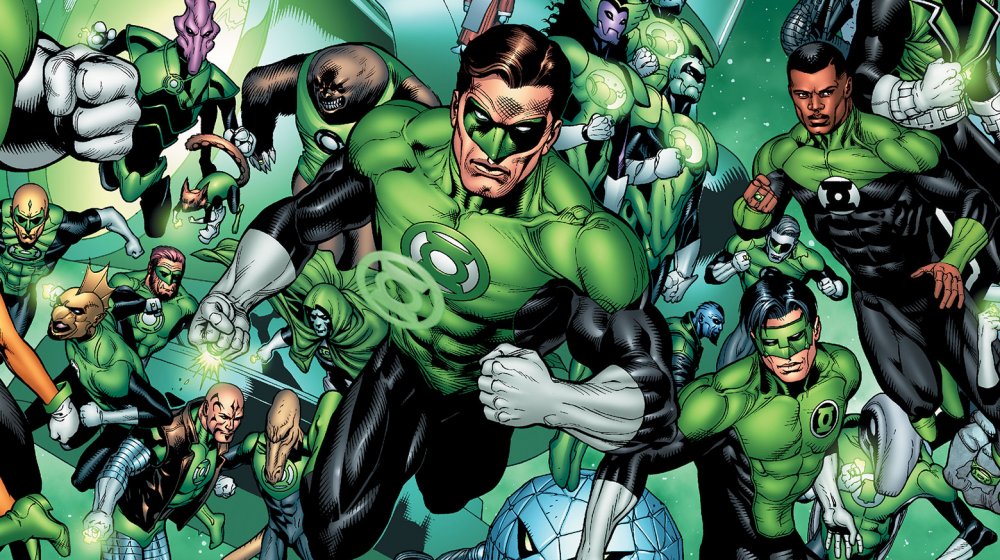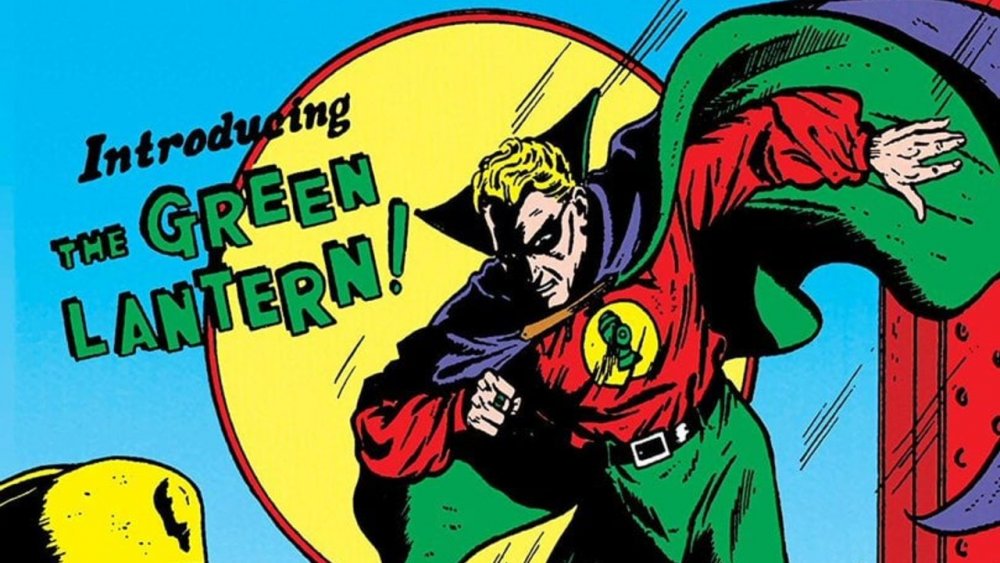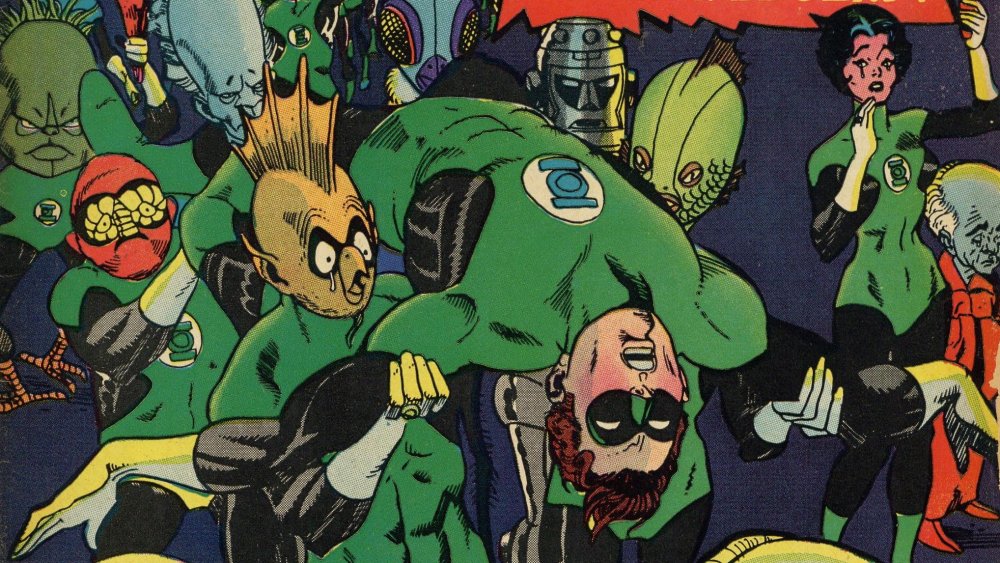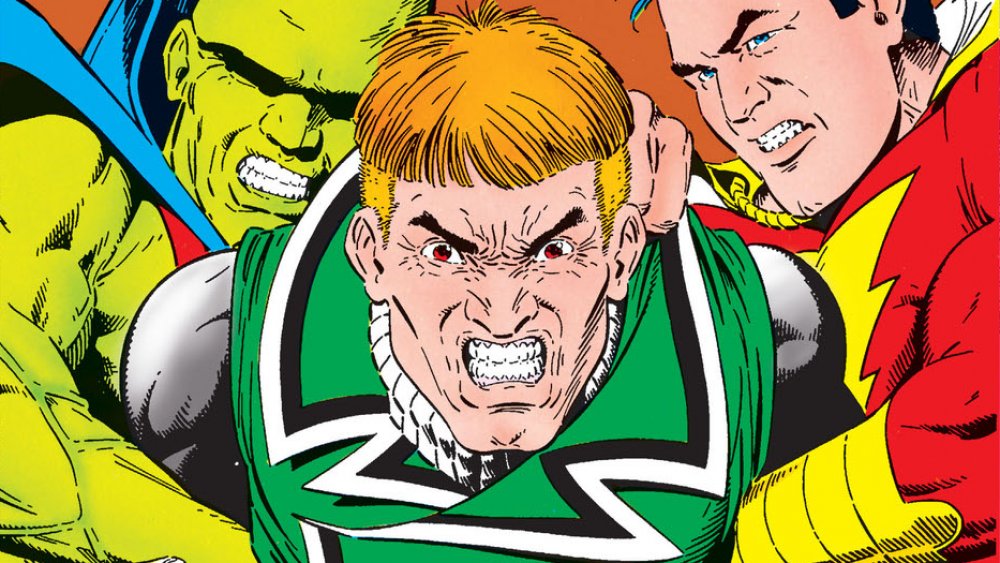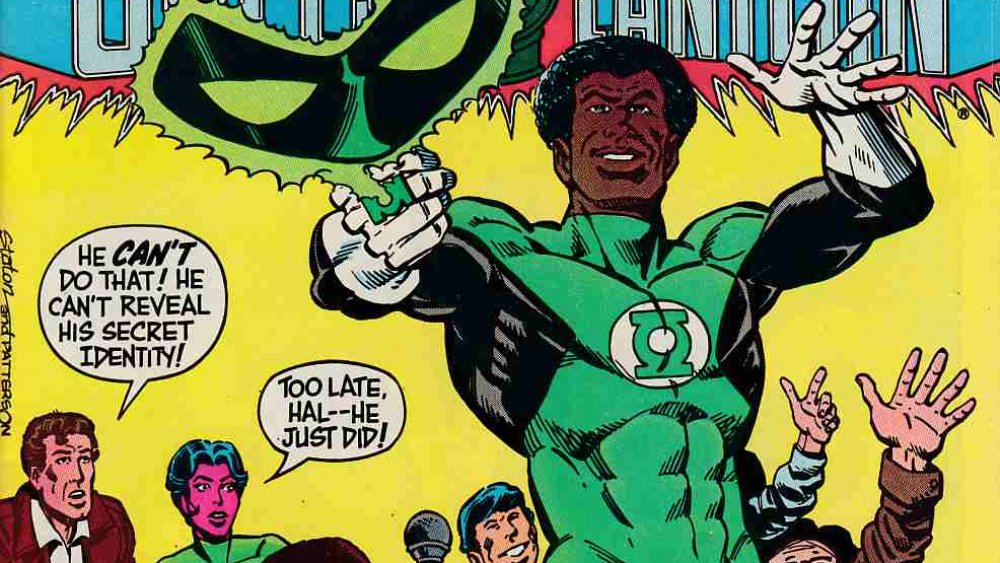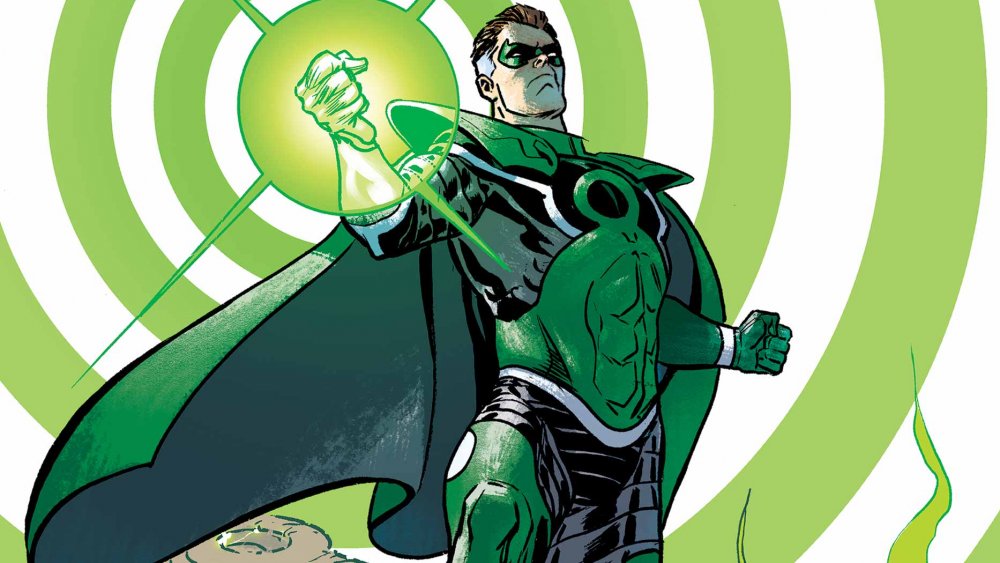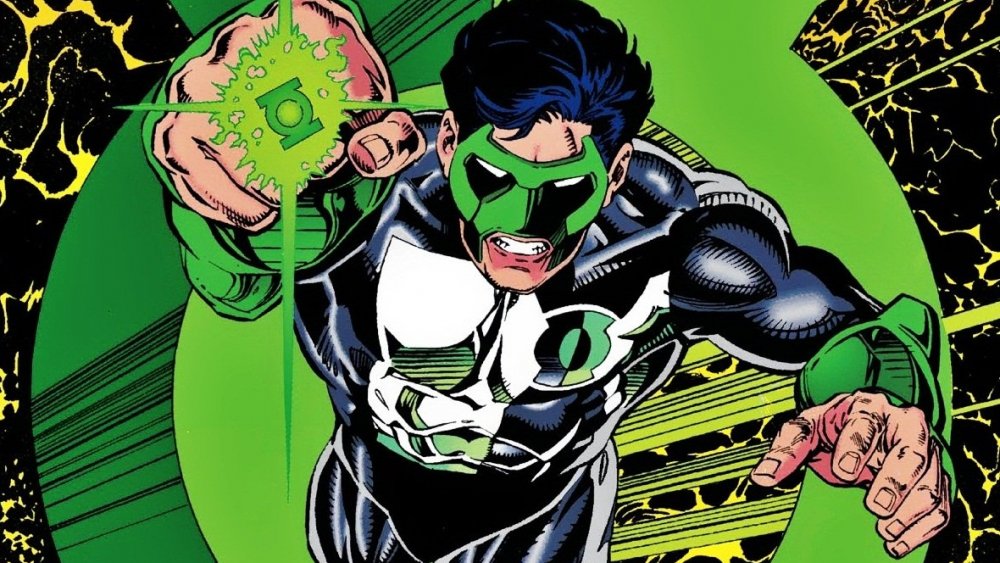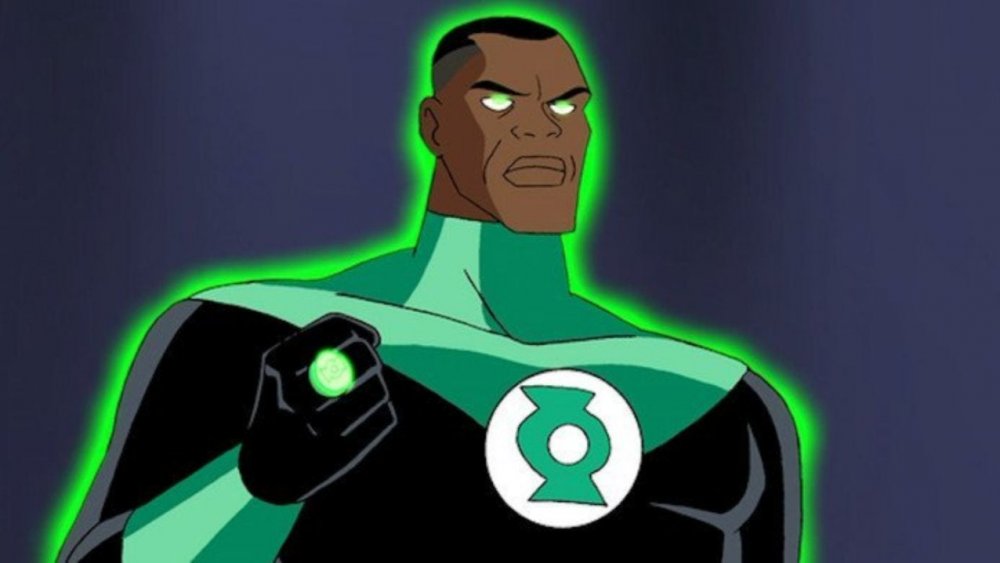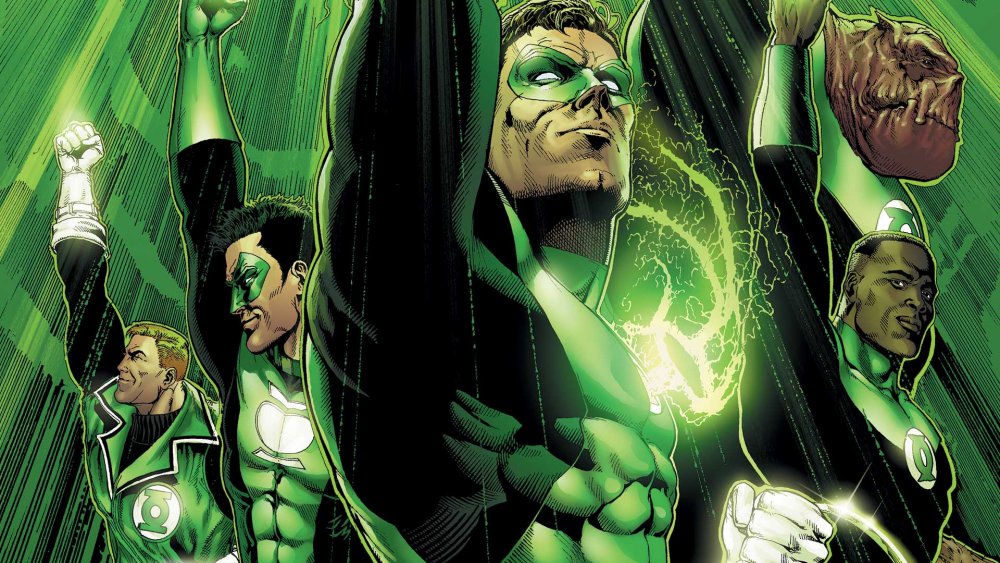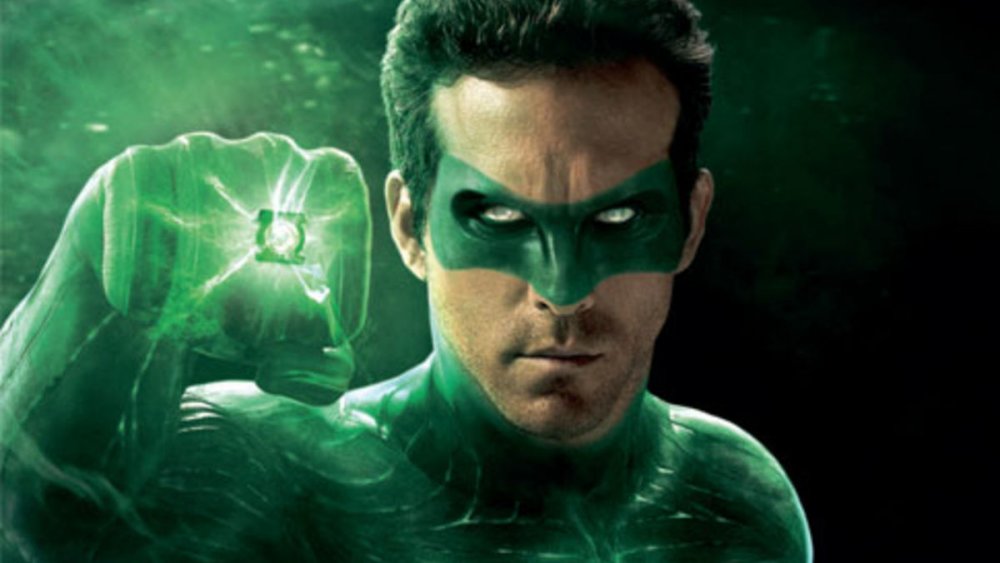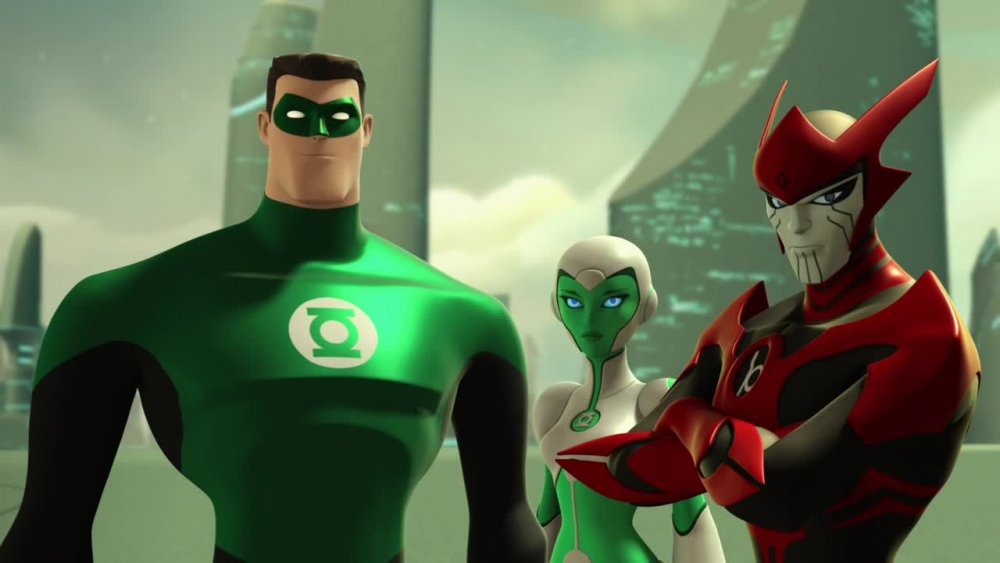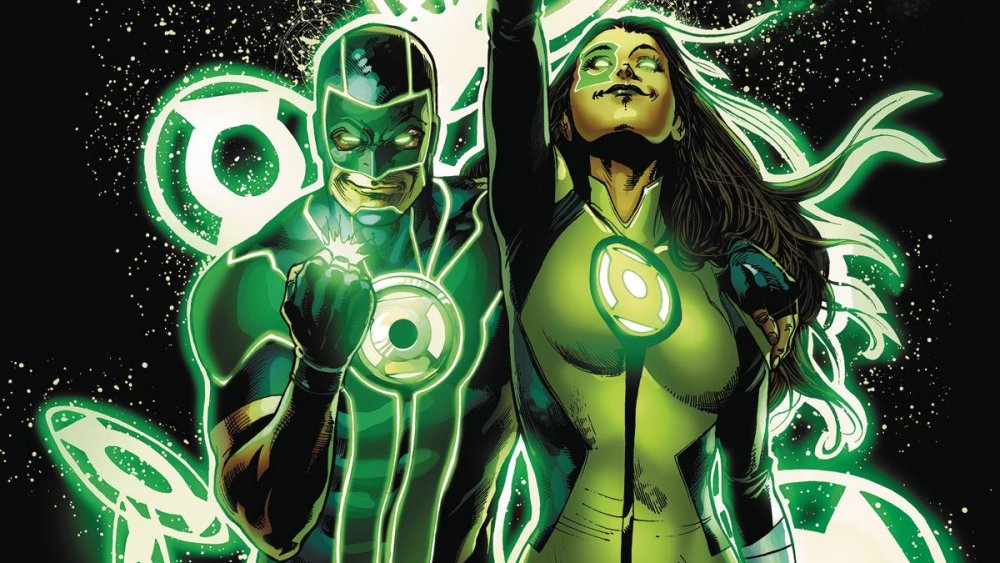The Untold Truth Of Green Lantern
Green Lantern has always stood out among DC Comics' major superheroes. The rest of the Justice League is more straightforward: Flash is a guy who runs fast, Aquaman controls the sea, Superman can do everything, Batman is the world's greatest detective, Wonder Woman is an Amazon princess, and Martian Manhunter is an alien. They're archetypal superheroes who make sense — the sort you gotta have for your super team. But there didn't have to be a Green Lantern. A guy with a ring he got from aliens, which he uses to create anything he can think of out of green energy stored in a battery that looks like a lantern? It's all just a little more out there.
Much of that distinctive detail comes from Martin Nodell, Green Lantern's creator. "I picked out the name from the train man on the tracks who was waving a lantern, going from red to green," explained Nodell. "Green meant go and I decided that was it. Then I needed a colorful and interesting costume. I was interested in Greek mythology and so the costume took on elements of that. It just all fell into place."
80 years after Nodell created this one-of-a-kind hero, he's a bigger name than ever. This is the history of DC's Green Lantern, from the pages of the 1940s to the TV screens of the modern day.
Alan Scott, the Golden Age Green Lantern
The original Green Lantern that Martin Nodell created is named Alan Scott, first appearing in 1940's All-American Comics #16. With his red shirt and purple cape, Scott looks nothing like the other Green Lanterns who would follow in his footsteps, and his origin is quite different too. Rather than being from outer space, Alan Scott's ring and lantern are ancient magical artifacts, which he came upon by chance and uses to fight criminals, Nazis, and supervillains throughout the 1940s. In addition to appearing in All-American Comics, Green Lantern soon got his own title, and became a member of the Justice Society of America in the pages of All-Star Comics.
Although his initial run ended with the Golden Age of comics in the early 1950s, Alan Scott would return many times over the years, although he'd never again be the Earth's primary Green Lantern. Like many of DC's Golden Age heroes, he was given space to age, get married, retire, and have children who grow up. All of that was erased with 2011's New 52 reboot, but more recent DC comics have begun bringing that old history back.
Hal Jordan and the Green Lantern Corps
As the 1950s drew to a close, DC Comics began bringing back old heroes with new looks and updated origins. A new Green Lantern was introduced in 1959's Showcase #22: Hal Jordan, a test pilot who gets his ring and lantern from an alien in a crashed spaceship.
Jordan's costume was changed to match his sleek new sci-fi origin, trading in Alan Scott's opera cape for a simple bodysuit, designed by the legendary Gil Kane. Although it fits the definition of a superhero costume, it also works as the uniform of an interstellar policeman — which is just what Hal Jordan is. Kane and writer John Broome introduced readers to the Green Lantern Corps, a organization of interstellar peacekeepers. The Corps is run by the Guardians of the Universe, a bunch of big-craniumed aliens who claim to know what's best for everybody, and consists of Green Lanterns from thousands of different worlds, each with their own ring, lantern-battery, and uniform. Some Corps members, like Tomar-Re and Kilowog, have become beloved characters in their own right.
Over the years, Hal Jordan has had his share of conflicts with other members of the Corps. One Green Lantern, the ominously-named Sinestro, even goes rogue, becoming Hal's greatest nemesis. Hal, in turn, has become known as the greatest Green Lantern, and a founder of the Justice League of America.
Guy Gardner, a Green Lantern for the '80s
In 1968, John Broome and Gil Kane introduced the idea that there must be more than one human man on the entire Earth who could have become Green Lantern. 1968's Green Lantern #59 thus introduced Guy Gardner, who was just as worthy a candidate as Hal Jordan, but was farther away from the crash that saw Jordan gain his power ring. Gardner wasn't a particularly interesting character at the time, since his main trait was "just as good as Hal," and he didn't stick around. In fact, a few years later, when a new creative team wanted to introduce another Green Lantern (who we'll discuss momentarily), Gardner was said to have been badly injured in a bus crash.
In the 1980s, Steve Englehart and Joe Staton brought back Guy Gardner and gave him an entirely new personality. This Guy is a short-tempered and boorish macho man, often used to poke fun of 1980s notions of conventional masculinity. Over the years, however, this version of Guy has become a complex character in his own right, showing that someone can be heroic without necessarily being a nice person. He was also the main Green Lantern of the Justice League during the run of Keith Giffen, J. M. DeMatteis, and Kevin Maguire, fondly remembered today for its humorous tone and emphasis on character.
John Stewart becomes Green Lantern in the '70s
In 1971, writer Dennis O'Neil and artist Neal Adams didn't care about Guy Gardner, but they did like the idea of bringing in another human Green Lantern. So in Green Lantern #87, they introduced John Stewart. Stewart wasn't just the first Black Green Lantern — he was DC's first Black superhero period. John was introduced as an architect and a political thinker, much more cerebral than Hal or Guy.
1984 saw Hal Jordan quit the Green Lantern Corps, making John Stewart the primary Green Lantern of Earth. He shocks Hal and other heroes at the time by publicly revealing his identity as Green Lantern. He goes on to devote his life to the Corps, even marrying an alien Green Lantern named Katma Tui.
Although Hal Jordan inevitably returns and Guy Gardner goes on to become more prominent in the '80s, John Stewart has remained important to the Green Lantern franchise — especially in terms of its representation on TV.
Hal Jordan as a villain
In the early 1990s, the world of DC Comics was in upheaval. Superman was killed by Doomsday in the infamous "Death of Superman" storyline. Bane broke Batman's back, leading Bruce Wayne to hand the cape and cowl over to the brutal Azrael. How do you introduce that kind of chaos into Green Lantern's corner of the DC universe? It's a role that passes from person to person, making death a lot less dramatic. But DC found a way, and the doom that came for Green Lantern was bigger and darker than anything that had come before.
Writer Ron Marz and artist Daryl Banks arrived on Green Lantern in 1994 with issue 48, which tells the story of Hal Jordan losing his grip on reality after his hometown of Coast City is destroyed. Seeking power to restore the city and its inhabitants, an increasingly unhinged Hal absorbs the power of most of the Green Lantern Corps, killing many of its members as well as the Guardians of the Universe. Taking all that power into himself, Hal becomes the villain known as Parallax.
Parallax goes on to play an important villainous role in the DC universe for several years, before sacrificing himself to re-ignite Earth's extinguished sun in the "Final Night" crossover event. In need of further redemption, Hal then takes on the role of the vastly powerful ghostly hero known as the Spectre.
Kyle Rayner, Green Lantern of the '90s
Though Hal Jordan destroyed the Green Lantern Corps, one ring was saved, finding its way to a young Earth man named Kyle Rayner. Created by Ron Marz and Daryl Banks, Kyle is an artist, which gives him a more creative perspective on using the ring's energy. For the next decade or so, Kyle was the only Green Lantern in a universe without a Corps or Guardians. That doesn't mean he spent those years lonely, however: He briefly joined the Titans, and then became part of a new version of the Justice League during Grant Morrison's JLA run.
When the other Green Lanterns eventually returned, it seemed like nobody was sure what to do with Kyle, whose role as the last Green Lantern had been so central to his character. He has at times taken on the name Ion, and is a main character in Tom King and Barnaby Bagenda's acclaimed 2015 series Omega Men, about a group of freedom fighters in deep space. Though he might not be the sole surviving Green Lantern any longer, he's still a major part of the DC universe.
John Stewart becomes a star on Justice League
Green Lantern has been part of DC animation for about as long as there has been DC animation at all. Hal Jordan appeared in short adventures on The Superman/Aquaman Hour of Adventure way back in 1967, and also appeared on Super Friends. However, neither of these shows had much in the way of characterization, so Green Lantern amounted to little more than his look and his powers.Things became slightly more substantial when Kyle Rayner appeared in a 1999 episode of Superman: The Animated Series entitled "In Brightest Day...," in which he's given Hal Jordan's origin and hair color. He never returned to the series after this introduction, however.
Everything changed when Justice League debuted on Cartoon Network in 2001, featuring John Stewart as Green Lantern. This John is a former Marine rather than an intellectual architect, but he retains his directness and honesty. He is a prominent member of the League throughout the original run of the show and its successor series, Justice League Unlimited. John even has the show's most prominent romance, with fellow Leaguer Hawkgirl.
John Stewart's popularity as a star of Justice League led to the character regaining prominence in comics. But it also caused his character to change, with his comics incarnation gaining the military background and attitude of his animated counterpart.
Hal and the Corps return
In 2004, DC Comics decided it was time to bring back all the classic Green Lantern lore they'd left behind a decade earlier. In the Green Lantern: Rebirth miniseries, Hal Jordan leaves the mantle of the Spectre behind and is given a new lease on life with both a corporeal body and a Green Lantern ring. Thus, Hal, Kyle Rayner, John Stewart, and Guy Gardner all serve as Green Lanterns of Earth, with the rest of the Green Lantern Corps returning, courtesy of the resurrected Guardians of the Universe.
Rebirth also establishes that Hal wasn't in control of himself when he went bad and slaughtered the Guardians and the Corps. Parallax, the retcon goes, was actually a powerful alien entity — basically a giant yellow space bug that feeds on fear — that took possession of Hal as he did his terrible deeds. The real Hal Jordan was a hero after all.
The Green Lantern movie
In 2011, Green Lantern came to the big screen. Directed by Martin Campbell, the film stars Ryan Reynolds as Hal Jordan, Blake Lively as his love interest Carol Ferris, Mark Strong as Sinestro, and Peter Sarsgaard as Hector Hammond. Hammond, a Silver Age Green Lantern villain with a super-brain, is the primary antagonist, although Parallax (the cosmic fear entity, here explained as a rogue Guardian of the Universe) is plotting in the background. Strong's Sinestro is a highlight of the movie, and is set up to become the villain of the sequel.
Saving Sinestro would prove to be a mistake, as the movie was critically panned and failed to impress at the box office. There was, unsurprisingly, no sequel. In fact, this movie was such a disappointment that there is no Green Lantern in 2017's Justice League, and filmmakers are still working out how to bring the Green Lantern Corps into the DCEU at all.
Today, the greatest legacy of the Green Lantern movie is the gag in Deadpool 2, in which Ryan Reynolds goes back in time to stop himself from being in the movie at all.
The Green Lantern animated series
By the time the Green Lantern movie failed, Green Lantern: The Animated Series was already in the midst of production. It was developed by Bruce Timm, who gave the DC animated universe its distinct look, but this series was in a new continuity, and animated with computer graphics instead of traditional 2D animation like Timm's previous projects.
This series takes Hal Jordan away from Earth for a mission into "frontier space" alongside the alien Green Lantern Kilowog, an android named Aya, and a Red Lantern named Razer. Guy Gardner is also a recurring character, as are many other Green Lanterns from the comics. John Stewart is mentioned and clearly set up to appear in a subsequent season, but by that time, the movie had cratered and nobody was buying any Green Lantern toys. Thus, the show was canceled.
That doesn't mean Green Lantern hasn't shown up in other animated projects, however. In addition to Hal's appearances in DC's popular direct-to-video movies, Guy Gardner was a supporting character on Batman: The Brave and the Bold, and Jessica Cruz is currently a regular on DC Super-Hero Girls.
Simon Baz and Jessica Cruz, Green Lanterns for the new millennium
In the last decade, two more human Green Lanterns joined the roster. Simon Baz debuted in 2012, first in a Free Comic Book Day special, and then in Green Lantern #0. Created by Geoff Johns and artist Doug Mahnke, Baz is a Lebanese-American Muslim from Dearborn, Michigan. A former car thief wrongly arrested for terrorism, becoming a Green Lantern gives him a chance to prove what heroism he's capable of.
The next year, in Justice League #30, another new Green Lantern was introduced. Jessica Cruz is first targeted by an evil power ring from an alternate Earth, but upon overcoming its power, she is given a proper Green Lantern ring. A Latina woman who deals with anxiety and PTSD, Jessica has opened the door to new kinds of stories about heroism and courage. Simon Baz and Jessica Cruz frequently work as partners, and even join the Justice League in tandem, in addition to starring in their own Green Lanterns (note the plural) comic.
All told, there are six prominent Green Lanterns of Earth in DC Comics (not counting Alan Scott), all of whom have been in the Justice League. Surely, given enough time, energy, and talent, Warner Bros. can figure out how to make a good movie out of at least one of them, right? Fingers crossed.
